The internet hosts over 1.1 billion websites as of September 2024, according to a report by Musemind. Only about 17% or roughly 192 million of these sites are actively maintained and updated. We rely on these active websites daily for communication, work, shopping, and entertainment. Regardless of their style, dynamics, functionalities, and technologies, this continued growth shows how much websites play a big part in our daily lives.
To build efficient websites today, web designers and developers need to combine several technologies, from HTML and CSS to client-side and server-side scripting and databases. These tools help shape both how the site runs and how visitors experience it. In terms of approach, web development typically falls into static and dynamic categories. Each one serves different use cases, project types, and business needs.
Given the technical terms involved, it's not surprising that these two concepts often confuse, especially now that modern tools blur the lines between them. A website may include advanced features, but that doesn't always make it dynamic. The good news is that there are still apparent differences between static and dynamic sites, and each fits better depending on the project's goals.
In the following sections of this article, we'll walk you through everything you need to know to clear up any uncertainty between static and dynamic websites, covering definitions, key components, real-world examples, and a step-by-step guide to building a static site to help you determine if it's the right choice for your project.
What Is a Static Website?
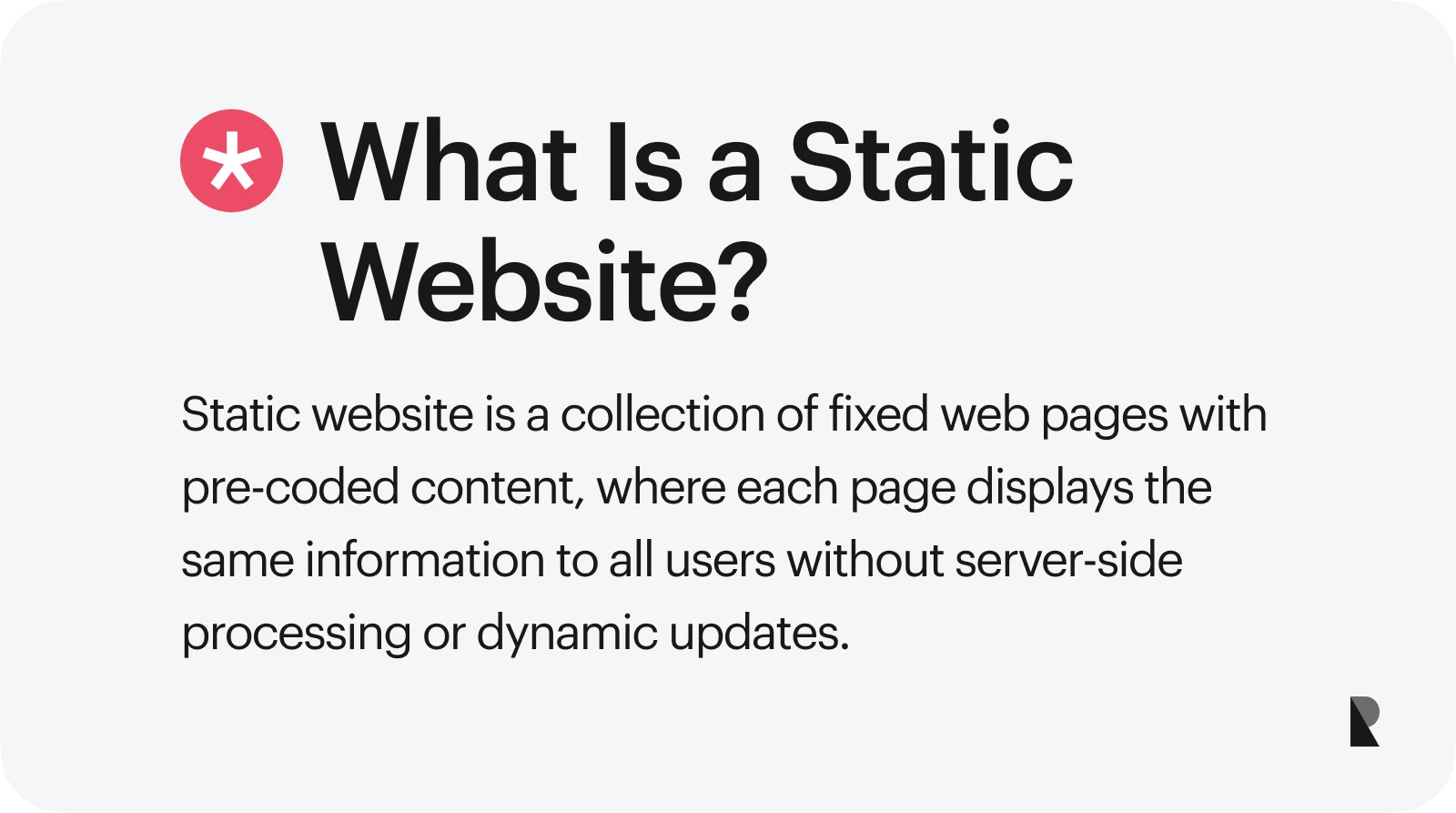
A static website comprises pre-built pages built with front-end technologies (client-side languages) like HTML, CSS, and JavaScript. These pages are stored on the server as HTML files and display the duplicate content every time they’re loaded, which is why they’re referred to as “static”.
To display the content of a static page, users request a page by entering a direct URL, sometimes including the name of the HTML file. The server then returns that exact file, which the browser loads and displays. A static website provides identical content to every user, no matter their device—be it a desktop, tablet, or mobile phone. This approach simplifies maintenance since you can update the file directly, and the changes will automatically appear on all connected pages.
A static site doesn't handle real-time interactions with databases or process user input on the server. They are commonly used to display text, graphics, or even videos. However, in recent years, modern technologies like Static Site Generators (SSGs) such as Hugo, Jekyll, and Next.js in static mode and headless CMSs like Contentful and Strapi have greatly expanded what static websites can do.
Static Website Examples
For many website projects, static sites remain a valuable and appealing option despite their limited functionality and lack of personalization.
Here are a few typical examples of static websites, along with brief descriptions and the tools commonly used to build them:
1. Portfolio websites

Static websites are perfect for this kind of content: simple, fast, and consistent for every visitor. (Image Source)
A static website is ideal for displaying your recent projects and achievements on a web page. Sections like About Me, Projects, Skills, and Contact typically contain fixed content that doesn’t change, require user input, or pull from a database.
Because there’s no need for user logins, real-time updates, or server-side processing, a portfolio site is one clear example of when a static site is the right choice.
Common technologies used:
- Static site generators like Hugo, Jekyll, and Gatsby
- JAMStack with Content Delivery Network (CDN)
2. Landing pages

Landing pages are usually built with consistent sections like headlines, CTAs, and testimonials, which are perfect for static sites since they don’t need a database or server logic. (Image Source)
A static website is ideal for displaying your recent projects and achievements on a web page. Sections like About Me, Projects, Skills, and Contact typically contain fixed content that doesn’t change, require user input, or pull from a database.
Because there’s no need for user logins, real-time updates, or server-side processing, a portfolio site is one clear example of when a static site is the right choice.
Common technologies used:
- Dedicated page builders such as Webflow, Framer, or Instapage
- Static site generators including Next.js or Gatsby
3. Documentation web pages
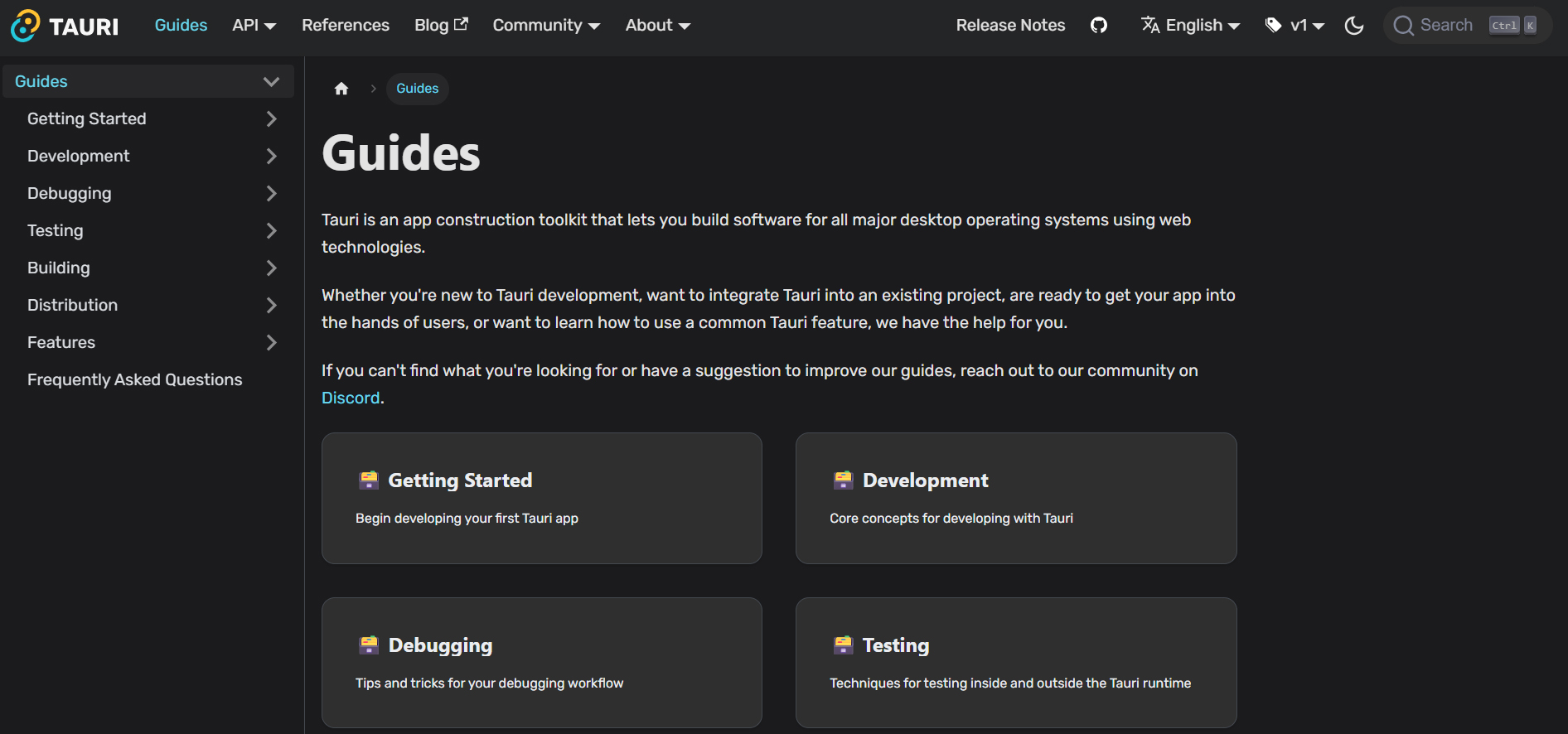
Documentation web pages are excellent use cases for static websites. Guides, tutorials, and API references don’t change frequently and are easy to structure. (Image Source)
Documentation is an excellent example of how static websites can be effectively used. Resources pages like product guides, coding tutorials, and API integration references are typically well-structured, categorized, and don’t require frequent updates.
Without the need for live updates or server-side functionality, static sites offer better speed and scalability.
*Common technologies used: *
- Static site generators like Hugo, Docusaurus, and VuePress
- Headless CMS like Strapi or Netlify CMS
Evolution of Static Websites

The first static websites were created by Sir Tim Berners-Lee at CERN (shown in the photo above). These early pages were built with raw HTML—just plain text, links, and a few images, with no styling or interactive features. (Image Source)
The development of static websites has been remarkably long since the internet's early days.
Sir Tim Berners-Lee introduced static sites at CERN in the 1990s. These early web pages were built using hand-coded HTML and offered little to no styling or interactivity. There were no dynamic features—just basic text, hyperlinks, and images. Making changes to a static site meant manually editing each HTML file individually.
As technology advanced, the demand for interactivity and data-driven integration grew. This led to the introduction of server-side scripting technologies, starting with the Common Gateway Interface (CGI). It was followed by the inception of popular scripting languages such as PHP (Hypertext Preprocessor), ASP (Active Server Pages), and JSP (Jakarta Server Pages), which emerged between 1994 and 1999.
Although scripting languages significantly improved web development, they didn’t stop static websites from evolving and improving. According to CloudCannon, the earliest form of what we now call a static website generator was a tool named HSC (short for "HTML Sucks Completely"), created by Thomas Aglassinger in 1996. Back then, it wasn’t officially called a "static site generator," but an "HTML preprocessor." The term static site generator didn’t emerge until the late 2000s.
Fast-forward to 2008, when Jekyll, created by Tom Preston-Werner, was introduced as one of the earliest and most influential SSGs. It gained popularity for its simplicity and efficiency in automating website creation through templates and serving web page content without the need for server-side logic, making it a go-to tool for personal projects and marketing sites.
From the early days up to now, several technologies have reshaped how a static website is built. Website technologies like JAMstack (JavaScript, APIs, Markup), modern static site generators such as Gatsby and Hugo, and headless CMS platforms like Strapi and Netlify CMS have been released to streamline and automate static site creation more efficiently.
How Does a Static Website Work?
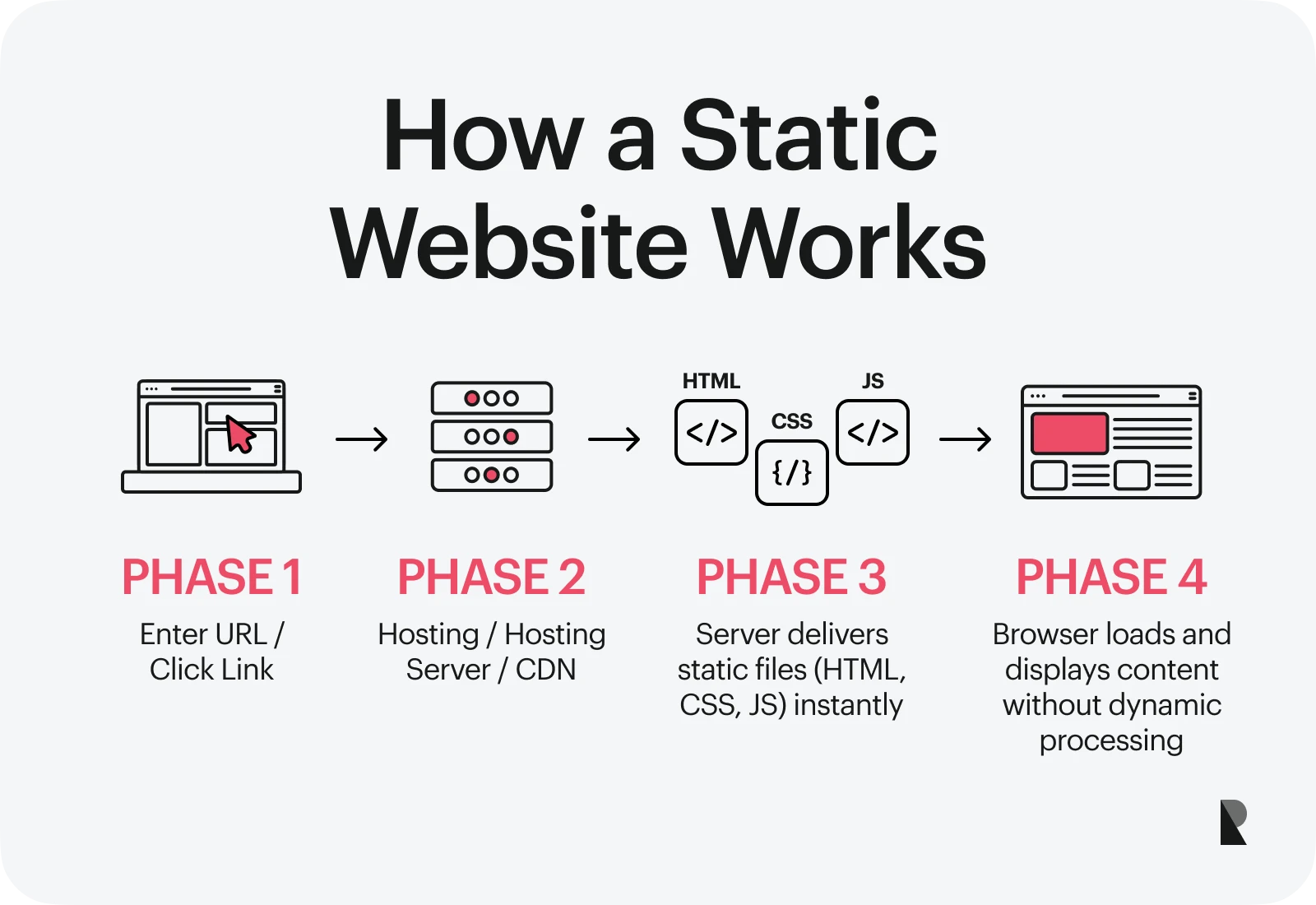
A static website goes through four main phases: it starts when a user enters a URL or clicks a link, and ends when the browser loads the page content without dynamic processing. (Image Source)
A static website is typically stored in cloud-based host servers. The files, written in client-side languages like HTML, CSS, and JavaScript, are delivered directly to the browser and displayed depending on the user’s device or screen size.
To simplify how a static website works behind the scenes, here’s a step-by-step breakdown of the request-response process:
Phase 1: The user enters a URL (e.g., example.com/about) or clicks a link in their browser.
Phase 2: The browser sends a request to the hosting server or CDN where the static files are stored.
Phase 3: The server responds by delivering the static files (HTML, CSS, JavaScript) almost instantly.
Phase 4: The browser loads and displays the web page content without additional processing or dynamic rendering.
The Role of a Browser in Static Website Rendering
When a user visits a website, several processes happen in the background. The browser not only interprets and processes the code to build the web page but also handles several important behind-the-scenes tasks.
Here are some primary roles the browser plays in rendering a static website:
The browser reads the static site’s pre-generated HTML file, builds the DOM (Document Object Model), and the CSSOM (CSS Object Model) to display the page content.
It’s also responsible for loading and applying CSS styles that define the web page's layout, colors, fonts, and other visual elements.
If the static website includes JavaScript, such as animations or form validation, the browser renders it on the client side.
Key Components of Modern Static Websites
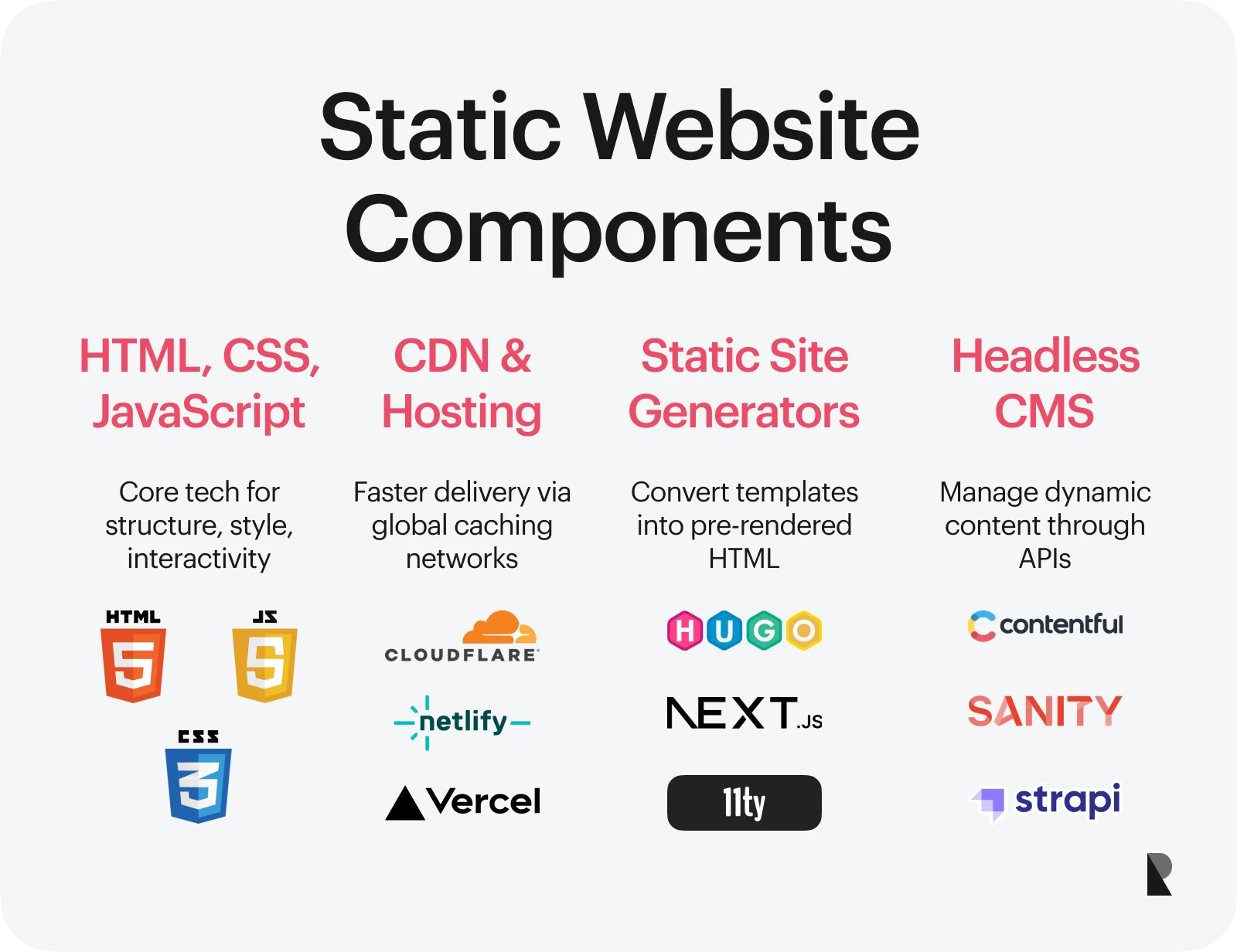
Modern static websites are built with standard web technologies and tools, which eliminates the need for server-side work and complex backend systems.(Image Source)
Businesses love static websites because they load extremely fast, reduce security headaches, and cost less than traditional sites.
Static sites are built using standard web technologies and modern tools, eliminating the hassle of heavy server-side work and complicated backend processing.
Below are the core components that make up a modern static website:
1. HTML, CSS, JavaScript
HTML, CSS, and JavaScript are the three core technologies of a static website.
HTML (Hypertext Markup Language) is a standard markup language used to structure and organize the content of web pages, including elements like headings, paragraphs, hyperlinks, and images.
CSS (Cascading Style Sheets) is a style sheet language that handles the design and layout of colors and fonts, as well as responsive behavior across devices.
JavaScript, on the other hand, is a client-side programming language that enables interactive features like animations and dynamic user experiences.
2. CDN and hosting for static sites
A Content Delivery Network (CDN) such as Cloudflare, Netlify, or Vercel helps static websites load faster by delivering pre-built assets like HTML, CSS, JavaScript, images, and videos from servers worldwide.
Instead of relying on a single origin server, CDNs cache content closer to the user, which reduces the static sites' bandwidth usage and improves global uptime.
3. Static site generators (SSG)
Modern static websites use Static Site Generators (SSGs) to convert templates and content such as Markdown or JSON into pre-rendered HTML files.
The result? Designers and developers can say goodbye to repetitive coding by managing multi-page structures, reusable layouts, and consistent design components.
Many static site generators (SSGs) exist, such as Harp.js, Next.js, Hugo, and Eleventy. Each tool is powered by unique features customized to different static website needs.
4. Headless CMS integration
A headless CMS separates content management from the website’s front-end design. This allows developers and non-technical users to update website content through a simple, intuitive dashboard.
During the build process, the static site generator (SSG) fetches this content via APIs and compiles it into pre-rendered static files. The result is a high-performing, scalable static website with dynamic content flexibility.
Some popular headless CMS platforms include Contentful, Sanity, and Strapi.
Static Website Pros and Cons
While a static website is ideal for its simplicity, speed, and low security risks, it also has limitations.
Here’s a breakdown of the advantages and disadvantages of a static site:
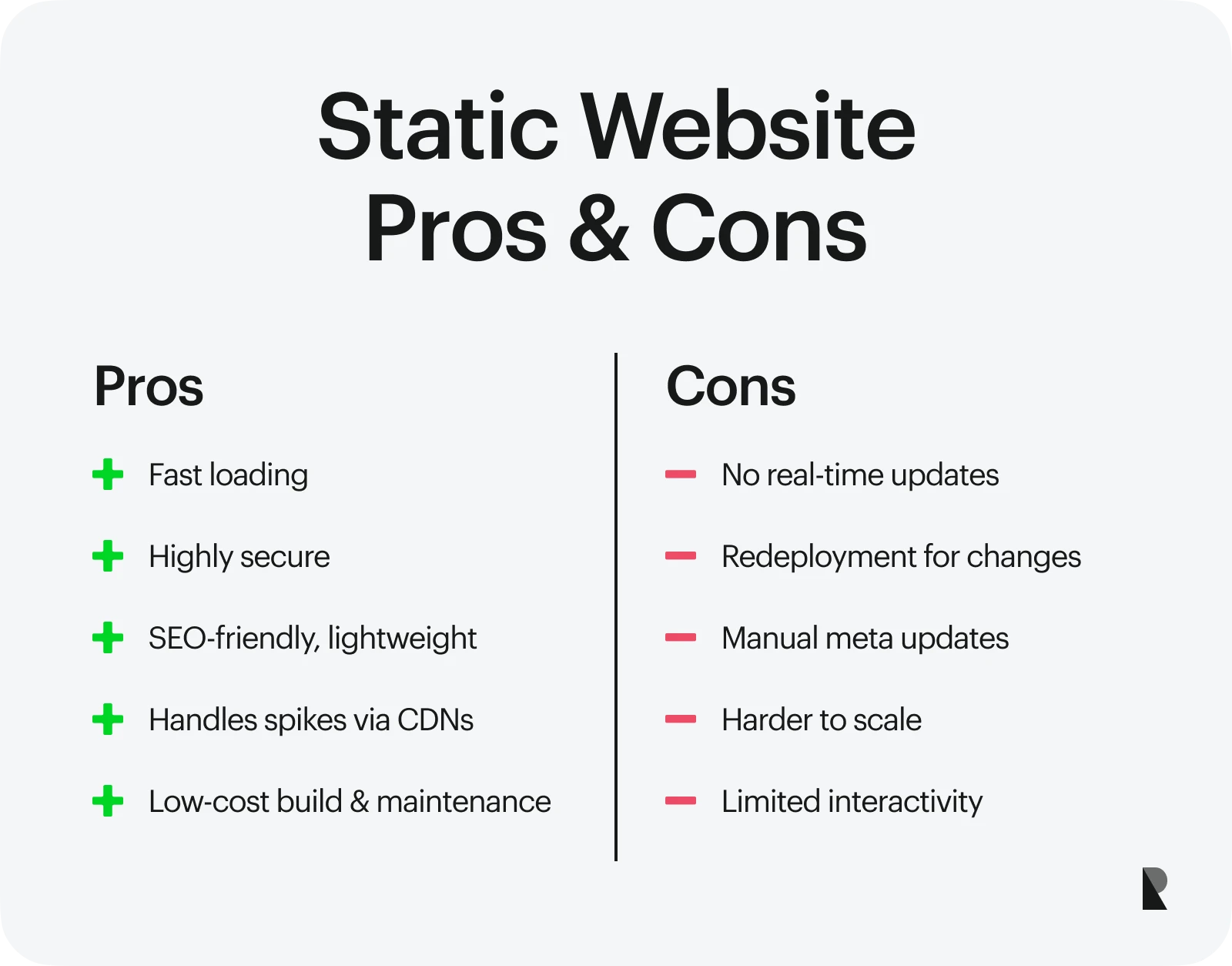
The table highlights the pros and cons of static websites, like fast loading, strong security, and SEO benefits, along with drawbacks such as limited scalability and no real-time updates. (Image Source)
What Is a Dynamic Website?

A dynamic website functions differently from a static website. It is interactive and capable of generating content on demand based on user input, requests, or real-time data.
Unlike a static site, a dynamic website relies heavily on server-side processing, database connections, dashboards, and front-end technologies to display the most up-to-date information in the browser. As a result, they offer personalized, functional, and data-driven user experiences that static websites cannot provide.
Dynamic websites are usually built with server-side languages like PHP, Ruby, or Python and rely on databases such as MySQL, PostgreSQL, or MongoDB to deliver personalized content to users.
Because of the added complexity in backend logic and database integration, developing a dynamic website generally requires hiring the best website design agencies, making it more costly than static site projects.
Dynamic Website Examples
Dynamic websites stand out in areas where static sites fall short.
By integrating advanced technologies, these websites can provide real-time data, custom content, and scalable features aligned with the business requirements.
Below are some of the most common examples and use cases of a dynamic website:
1. E-commerce store

E-commerce stores are great examples of dynamic websites. Users interact by browsing products, adding items to their cart, or making purchases. (Image Source)
E-commerce websites are one of the most common examples of dynamic websites.
Users interact with the website differently, from browsing products, adding items to the cart, or completing payments. While front-end technologies help present product information as seen in many static website examples, the core functionality of a dynamic site relies heavily on server-side processing and databases.
An e-commerce website typically generates the following elements dynamically upon each user request:
- Product listings and availability based on real-time inventory.
- Personalized recommendations based on browsing history or preferences.
- Shopping cart contents with dynamic pricing, regional taxes, and discount calculations.
- Secure checkout forms and real-time order summaries.
Common technologies used: Frontend: JavaScript, React.js, Vue.js, and Angular.js Backend: PHP, Node.js, Python, and Ruby on Rails Database: MySQL, MongoDB, and PostgreSQL
2. Booking System

Booking platforms for hotels, clinics, or services need dynamic features like real-time calendars, interactive forms, and instant email or SMS confirmations. A well-known example is Airbnb, where users can book homes, hotels, and more. (Image Source)
Booking websites for hotels, clinics, or service appointments need dynamic features to display real-time calendar availability, allow user interaction, and send instant confirmations via email or SMS.
A booking website generates the following elements dynamically upon each user request:
- Available date, time, and room slots
- User login/logout/session data
- Booking confirmation pages
- Dynamic calendars and search filters
- Automatic pricing and localized content
- Flexible language support
Common technologies used:
Frontend: React.js, Vue.js, Angular.js, and Svelte Backend: PHP, Node.js, Django, Laravel, Ruby on Rails, and Java (Spring Boot). Database: MySQL, PostgreSQL, and Firebase APIs: Stripe (payments), Twilio (SMS alerts).
Dynamic Website Pros and Cons
Whether you choose a static or dynamic website, each has its own set of best use cases and limitations. The perfect choice depends entirely on your website project’s goals, complexity, and content requirements.
To help you better understand, here’s a clear comparison of the advantages and disadvantages of dynamic websites:
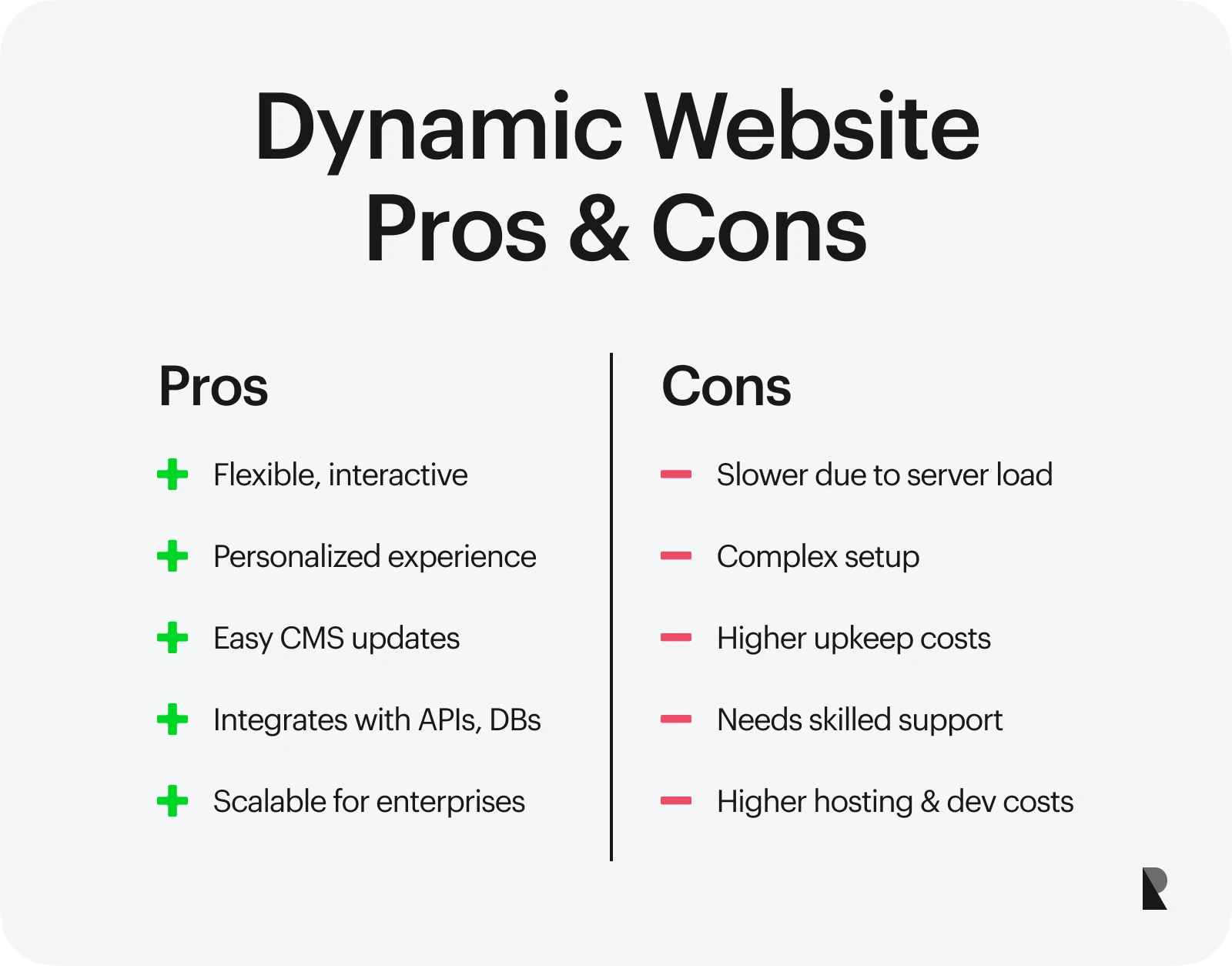
The table highlights the pros and cons of a dynamic website. While it is interactive, flexible, and easy to update with a CMS, it may load more slowly, cost more to maintain, and be more complex to build. (Image Source)
Static vs Dynamic: SSG vs Server-Side Platforms
Two popular rendering techniques are widely used in modern web development: SSR (Server-Side Rendering) and SSG (Static Site Generation).
Server-Side Rendering (SSR). Generates the HTML on the server for every user request, then sends it to the browser. This means the page is freshly rendered each time someone visits.
Static Site Generation (SSG). Creates all web pages at build time using raw content and templates without server-side processing. Since the content doesn't change based on user requests, the same pre-rendered page is delivered to every visitor.
Both static and dynamic websites have their own methods, tools, workflows, and content management styles. Whether you use SSG or SSR will always depend on the specific goals of the website project.
Let's examine the differences between Static Site Generators (SSGs) like Next.js and Hugo and Server-Side Rendering (SSR) using dynamic platforms such as WordPress and Laravel.
1. Performance comparison
SSG-based static websites are typically pre-built at deploy time and served via CDNs. This results in faster loading times, since most of the content is pre-rendered.
On the other hand, SSR-based dynamic websites generate content on demand, affecting latency. However, with proper optimization techniques (such as caching with Redis or Varnish), a dynamic website can load quickly enough to match the speed of a typical static site.
2. Scalability comparison
Static websites have a scalable infrastructure that allows them to grow easily. Since the content is pre-built and delivered through CDNs, they can handle high traffic spikes without backend server load, which keeps the website speed fast.
In contrast, a dynamic website requires more complex computing with server resources, such as APIs, databases, and backend logic to generate pages per request and scale efficiently. It needs strong optimization techniques like caching, database indexing, and load balancing to keep up with high traffic.
3. Content management differences
Static websites can efficiently manage content using headless CMSs (like Contentful or Strapi) or content files (such as Markdown via Git). To make content updates in the CMS fast (using webhooks), static sites are typically built and deployed through automated cloud platforms like Netlify or Vercel.
In contrast, dynamic platforms (e.g., WordPress, Drupal, Joomla) have built-in CMS features. The platform's admin panel tools and integrations allow users to update content quickly.
4. Use case table: static vs dynamic
The table below helps you understand where static vs. dynamic websites are best suited for specific use cases.
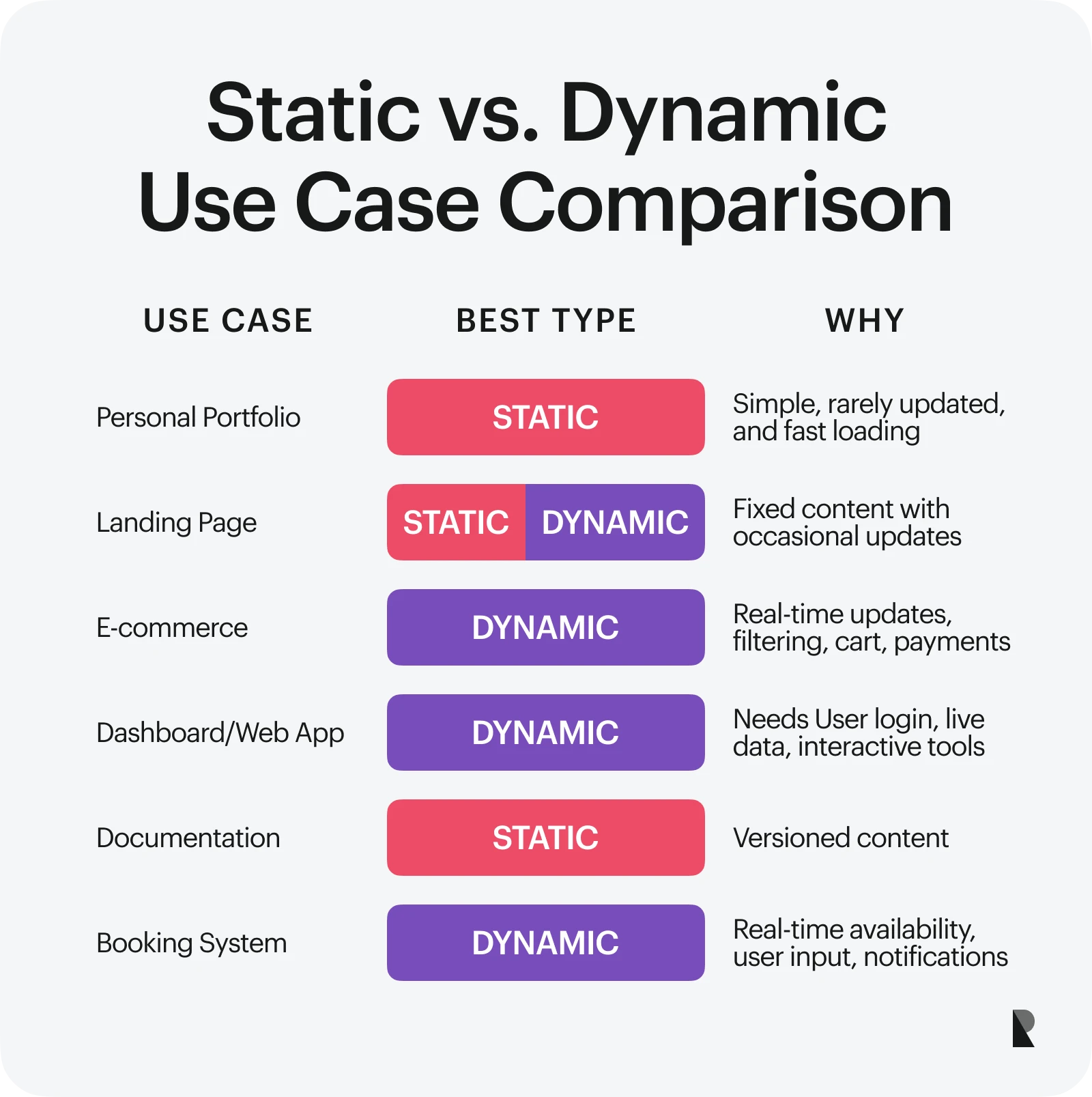
The table above compares static vs. dynamic website use cases, showing which type works best for different needs and functionalities, from portfolios to booking systems, and why. (Image Source)
How to Build a Static Website: Step-by-Step
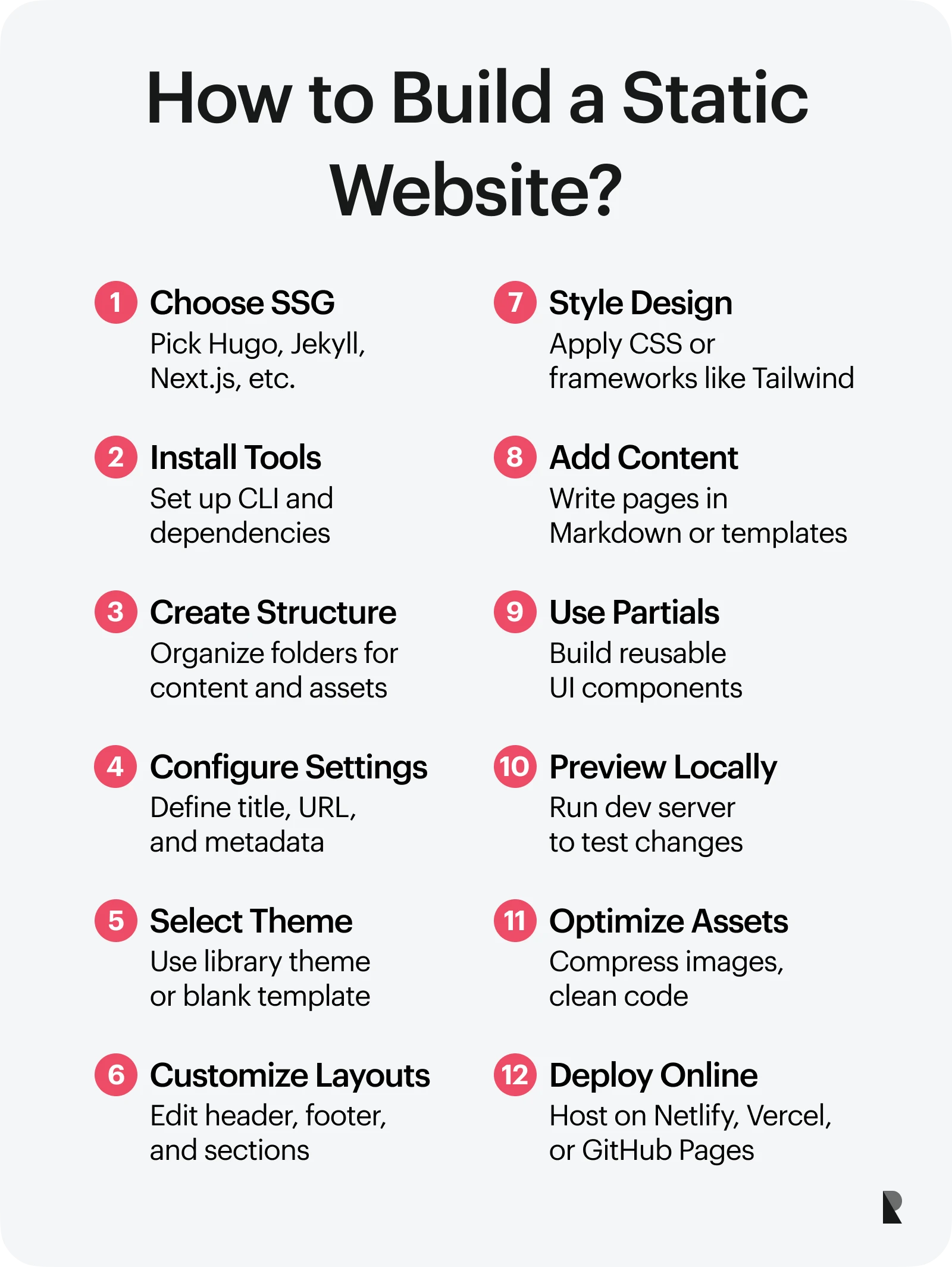
There are several ways to make static websites. Sure, you could hand-code everything in raw HTML, CSS, and JavaScript, but there's a more innovative approach unless you enjoy reinventing the wheel for every page.
For modern developers, static site generators are the secret weapon as they handle the repetitive work automatically so you can focus on what matters.
Let's go over how to build a static website step by step.
Step 1: Pick a static site generator (SSG)
Start by choosing a Static Site Generator for your project and skill level. Since most are tied to a certain programming language or tools, it's easiest to go with one you already know.
Here are some of the most commonly used Static Site Generators (SSGs), along with basic details about each:
1. Hugo
- Speedy build times and a wide selection of themes
- Useful for blogs and documentation websites
- Works best with Go programming language
2. Jekyll
- Simple setup and easy to use
- Integrates smoothly with GitHub Pages
- Ideal for marketing sites, personal blogs, and e-commerce projects
- Written in Ruby. Uses Markdown, Textile, and Liquid templates to render content
3. Next.js
- Designed for static and server-rendered React applications
- SEO-friendly, flexible, and performance-focused
- Great for blogs, personal sites, portfolios, and e-commerce websites
- Works well with headless CMS setups
- Built on Node.js and integrates well with JavaScript stacks
Step 2: Set up project structure
Once you’ve chosen a Static Site Generator (SSG) for your project, the next step is to install its CLI tool or starter template. The setup process will differ depending on which SSG you’re using.
For example: * Hugo: choco install hugo -confirm * Jekyll: gem install jekyll bundler * Next.js: npx create-next-app@latest
Afterwards, you need to configure your folder structure. Although the specific organization may differ by framework, it usually adheres to a standard pattern:
**/content**– Markdown files or pages**/layouts**or**/templates**– HTML structure**/static**or**/public**– Images, JavaScript, fonts- config file – Site-wide settings (title, base URL, etc.)
3. Add templates and content
Every major SSG offers reusable templates ranging from minimalist starter kits to nearly complete websites.
You can explore theme libraries for Hugo, Jekyll, and Next.js to find a design that fits your project, then customize it to match your brand or layout preferences.
After choosing a theme or starting from scratch, the next step is to set up reusable templates for key parts of your site, like the header, footer, and primary content sections. Regarding styling, you can stick with plain CSS or SCSS, or use a CSS framework like Bootstrap, Tailwind, or Bulma, depending on your preference.
Use components or partials for repeated elements to keep your codebase clean and avoid redundancy.
4. Deploy the static site
To launch your static website online, you need to choose a hosting platform on which to deploy your project.
You can choose from Netlify, Vercel, GitHub Pages, or Cloudflare Pages. Of course, the best option for your project will depend on your tech stack, scalability requirements, and budget.
Pro tip: Deploy early and deploy often. Frequent deployment helps you catch bugs quickly and ensures smooth site updates.
Conclusion: Is Static the Right Choice?
A static site is a smart choice when your content doesn't change frequently, like for blogs, portfolios, or documentation, and you don't need real-time data or personalized content. It's the perfect solution if you're watching your budget, racing against a deadline, or just want to avoid technical headaches.
If you're unsure about building the site, partnering with a website design firm can help speed up the process and ensure a well-optimized, effective, static, or dynamic website.
Ultimately, what matters most is delivering a website that meets your goals and serves your audience in the best way possible.
Aug 25, 2025
